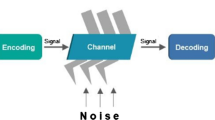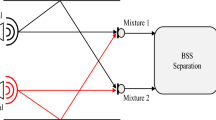Abstract
In this article, a generic model of minimum mean square error (MMSE) based speech enhancement technique has been presented and implemented on the hardware. Models for different MMSE-based methods were obtained by changing the gain function in the generic model. In all the methods, modified cascaded median-based noise estimation method has been used for noise estimation. Performances of all these MMSE-based methods were compared, among themselves and also with the spectral subtraction method for speech enhancement. The results have been evaluated using objective measures, subjective measure and composite objective measures for different noisy speech files. Results, in terms of objective evaluation parameters, indicated that the adaptive β-order MMSE method yielded better performance than the other methods. In subjective quality test (according to MOS listening test), β-order MMSE and adaptive β-order MMSE method yielded high scores. Real-time implementation has been carried out using TMS320C6416T DSP starter kit and code composer studio software. Estimation of memory consumption and execution time has been done for all the methods.








Similar content being viewed by others
Explore related subjects
Discover the latest articles, news and stories from top researchers in related subjects.References
Boll, S. F. (1979). Suppression of acoustic noise in speech using spectral subtraction. IEEE Transactions on Acoustics, Speech, and Signal Processing, 27(2), 113–120.
Chassaing, R. (2004). Digital signal processing and applications with the C6713 and C6416 DSK, Vol. 16. Hoboken, NJ: Wiley.
Cohen, I. (2004). On the decision-directed estimation approach of Ephraim and Malah. In IEEE International Conference on Acoustics, Speech, and Signal Processing, 2004. Proceedings.(ICASSP-04), Montreal, Canada.
El-Fattah, M. A., Dessouky, M.I. (2014).Speech enhancement with an adaptive Wiener filter. International Journal of Speech Technology, 17(1), 53–64.
Ephraim, Y., & Malah, D. (1984) Speech enhancement using a minimum mean-square error short-time spectral amplitude estimator. IEEE Transactions on Acoustics, Speech, and Signal Processing, 32(6), 1109–1121.
Ephraim, Y., & Malah, D. (1985) Speech enhancement using a minimum mean-square error log-spectral amplitude estimator. IEEE Transactions on Acoustics, Speech, and Signal Processing, 33(2), 443–445.
Goh, Z., Tan, K.-C., & Tan, T. G. (1998) Postprocessing method for suppressing musical noise generated by spectral subtraction. IEEE Transactions on Speech and Audio Processing 6(3), 287–292.
Hu, Y, & Loizou, P. C. (2008). Evaluation of objective quality measures for speech enhancement. IEEE Transactions on Audio, Speech, and Language Processing 16(1), 229–238.
Kumar, B. (2015). Spectral subtraction using modified cascaded median based noise estimation for speech enhancement. In ACM, 6th International Conference on Computer and Communication (ICCCT-15), MNNIT, Allahabad, India, 25–27 September 2015.
Kumar, B. (2016). Mean-median based noise estimation method using spectral subtraction for speech enhancement technique. Indian Journal of Science and Technology, 9, 35.
Kumar, S., Singh, S. K., & Bhattacharya, S. (2015). Performance evaluation of a ACF-AMDF based pitch detection scheme in real-time. International Journal of Speech Technology, 18(4), 521–527.
Pandey, P. C., & Tiwari, N. (2015). Speech enhancement using noise estimation based on dynamic quantile tracking for hearing impaired listeners. In IEEE, Proc. 21th National Conference on Communications (NCC 2015., IIT Mumbai, 2015).
Rix, A. W., et al. (2001) Perceptual evaluation of speech quality, an objective method for end-to-end speech quality assessment of narrowband telephone networks and speech codecs. ITU-T Recommendation.862.
Rix, A. W. (2003). Comparison between subjective listening quality and P. 862 PESQ score. In Proc. Meas. Speech Qual. Net.(MESAQIN) (pp. 17–25).
Kumar, S. (2016). Performance evaluation of novel AMDF-based pitch detection scheme. ETRI Journal, 38(3), 425–434.
Waddi, S. K., Pandey, T. C., & Tiwari N. (2013). Speech enhancement using spectral subtraction and cascaded-median based noise estimation for hearing impaired listeners. In IEEE, Twentieth National Conference on Communications (NCC), IIT Delhi.
Surendran, S., & Kumar, T. K. (2017). Variance normalized perceptual subspace speech enhancement. AEU-International Journal of Electronics and Communications, 74, 44–54.
Veisi, H., & Sameti, H. (2012). Hidden-Markov-model-based voice activity detector with high speech detection rate for speech enhancement. IET Signal Processing, 6(1), 54–63
Wei, H., Long, Y., & Mao, H. (2016). Improvements on self-adaptive voice activity detector for telephone data. International Journal of Speech Technology, 19(3), 623–630.
Yadava, T. G., & H. S. Jayanna. (2018) Speech enhancement by combining spectral subtraction and minimum mean square error-spectrum power estimator based on zero crossing. International Journal of Speech Technology. https://doi.org/10.1007/s10772-018-9506-9.
You, C. H., et al. (2003) Adaptive/spl beta/-order MMSE speech enhancement application for mobile communication in a car environment. In Fourth Pacific Rim Conference on Multimedia in Information, Communications and Signal Processing, vol. 3, IEEE.
You, C. H., Koh, S. N., & Rahardja, S. (2005). /spl beta/-order MMSE spectral amplitude estimation for speech enhancement. IEEE Transactions on Speech and Audio Processing, 13(4), 475–486.
Acknowledgements
I would like to thank Prof. Subrata Bhattacharya, Department of Electronics Engineering, Indian Institute of Technology (ISM), Dhanbad for his guidance and encouragement. I would also like to thank the Indian Institute of Technology (Indian School of Mines), Dhanbad for providing the financial support.
Author information
Authors and Affiliations
Corresponding author
Rights and permissions
About this article
Cite this article
Kumar, B. Comparative performance evaluation of MMSE-based speech enhancement techniques through simulation and real-time implementation. Int J Speech Technol 21, 1033–1044 (2018). https://doi.org/10.1007/s10772-018-09567-5
Received:
Accepted:
Published:
Issue Date:
DOI: https://doi.org/10.1007/s10772-018-09567-5




